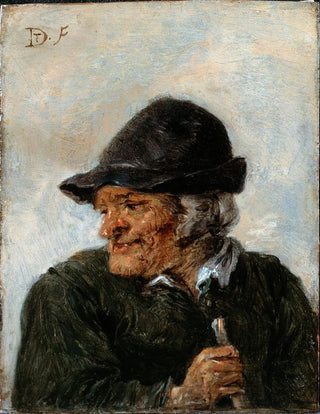Art print of a peasant - David Teniers the Younger | Art print


View from behind

Frame (optional)
In the vibrant world of 17th-century Flemish painting, the art print "Un paysan" by David Teniers the Younger stands out for its apparent simplicity and narrative depth. This artwork, which depicts the daily life of a peasant, immerses us in a world where everyday life and art meet with striking harmony. The scene, imbued with realism, invites the viewer to contemplate the beauty of ordinary gestures, to appreciate the light that dances across faces and elements of the setting. Through this piece, Teniers does not merely depict a frozen moment in time; he offers a reflection on the human condition, on work and the dignity that arises from it.
Style and uniqueness of the work
David Teniers the Younger’s style is characterized by technical mastery that allows him to capture the nuances of peasant life with remarkable delicacy. In "Un paysan," the choice of colors, ranging from earthy tones to luminous highlights, creates a warm and authentic atmosphere. Teniers excels in representing textures, whether it be the coarse canvas clothing of the protagonist or the natural elements surrounding him. The composition is carefully orchestrated, with each detail seemingly designed to reinforce the idea of a simple yet meaningful life. The expressions of the characters, although frozen on the canvas, convey a range of emotions that resonate with the viewer, inviting reflection on the story of these anonymous lives.
The artist and his influence
David Teniers the Younger, son of a painter, established himself as one of the masters of his time, notably through his ability to blend realism and poetry. His career is marked by a deep admiration for rural life, which is evident in many of his works. Teniers captured the essence of Flemish society, paying homage to the dignity of the worker while offering a critical view of the morals of his era. His influence extends well beyond his contemporaries, inspiring many artists who followed his path. By incorporating elements of daily life into his paintings, Teniers opened the

Matte finish

View from behind

Frame (optional)
In the vibrant world of 17th-century Flemish painting, the art print "Un paysan" by David Teniers the Younger stands out for its apparent simplicity and narrative depth. This artwork, which depicts the daily life of a peasant, immerses us in a world where everyday life and art meet with striking harmony. The scene, imbued with realism, invites the viewer to contemplate the beauty of ordinary gestures, to appreciate the light that dances across faces and elements of the setting. Through this piece, Teniers does not merely depict a frozen moment in time; he offers a reflection on the human condition, on work and the dignity that arises from it.
Style and uniqueness of the work
David Teniers the Younger’s style is characterized by technical mastery that allows him to capture the nuances of peasant life with remarkable delicacy. In "Un paysan," the choice of colors, ranging from earthy tones to luminous highlights, creates a warm and authentic atmosphere. Teniers excels in representing textures, whether it be the coarse canvas clothing of the protagonist or the natural elements surrounding him. The composition is carefully orchestrated, with each detail seemingly designed to reinforce the idea of a simple yet meaningful life. The expressions of the characters, although frozen on the canvas, convey a range of emotions that resonate with the viewer, inviting reflection on the story of these anonymous lives.
The artist and his influence
David Teniers the Younger, son of a painter, established himself as one of the masters of his time, notably through his ability to blend realism and poetry. His career is marked by a deep admiration for rural life, which is evident in many of his works. Teniers captured the essence of Flemish society, paying homage to the dignity of the worker while offering a critical view of the morals of his era. His influence extends well beyond his contemporaries, inspiring many artists who followed his path. By incorporating elements of daily life into his paintings, Teniers opened the
12,34 €






